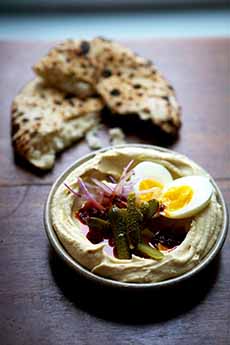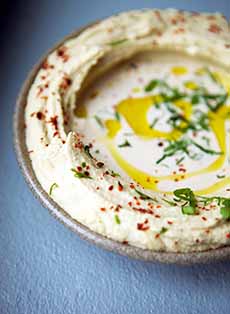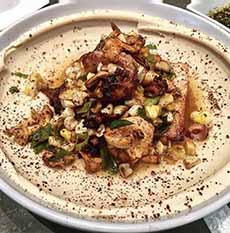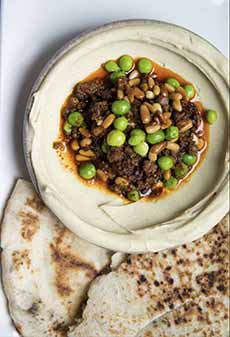Hummus Garnishes For National Hummus Day
|
You can garnish plain hummus with a drizzle of olive oil. Get fancier by adding some paprika and flat parsley leaves. Get even fancier with sprinkle of whole chickpeas—the base ingredient of hummus. Roast them yourself or buy roasted chickpea snacks for a step further. But the James Beard Award-winning Shaya Restaurant in New Orleans knows how to dazzle. Its take on modern Israeli cuisine draws inspiration from the cuisines of Eastern Europe, Greece, the Middle East, North Africa and Turkey. And some of those influences are turned into hummus toppings. First, there’s the simple approach: olive oil and sumac (photo #2). But expand your horizons to toppings like these: Start experimenting today! Chickpeas, sesame, lemon, and garlic have been eaten in the Levant* for millennia. Though widely consumed, chickpeas were cooked in stews and other hot dishes. Puréed chickpeas eaten cold with tahini do not appear before the Abbasid period (750 to 1517 C.E.) in Egypt and the Levant†. The earliest known recipes for a dish similar to hummus are in 13th-century cookbooks from Cairo. Some food historians believe the paste appeared a century earlier, prepared by Saladin, who was the first sultan of the Ayyubid dynasty (1174–1193). (That is to say, it was created by one of Saladin’s chefs.) If so, it was more likely created by a cook in his kitchen, the idea of the warlord Saladin-as-cook being tough to swallow. Recipes for cold purée of chickpeas without tahini, but with vinegar, oil, pickled lemons, herbs and spices—but no garlic—appear in medieval cookbooks; as do recipes with nuts vinegar (though not lemon), with many spices and herbs. Whomever and however, we’re grateful that it came to be part of our [almost] daily diet. |
|
|
|
________________ *The Levant is an English term that first appeared in 1497. It originally referred to the “Mediterranean lands east of Italy.” The historical area comprises modern-day Iraq, Israel, Jordan, Lebanon, Palestine and Syria. Among other popular foods, Levantine cuisine gave birth to baklava, balafel, kebabs, mezze (including tabbouleh, hummus and baba ghanoush), pita and za’atar, among other dishes that are enjoyed in the U.S. and around the world. †Jammy eggs are eggs cooked until the white is set but still tender, and the yolk has a soft, custardy, spreadable texture. It is a soft-boiled egg, but one where the yolk isn’t runny, but somewhere between soft-boiled and hard-boiled.
|
||




